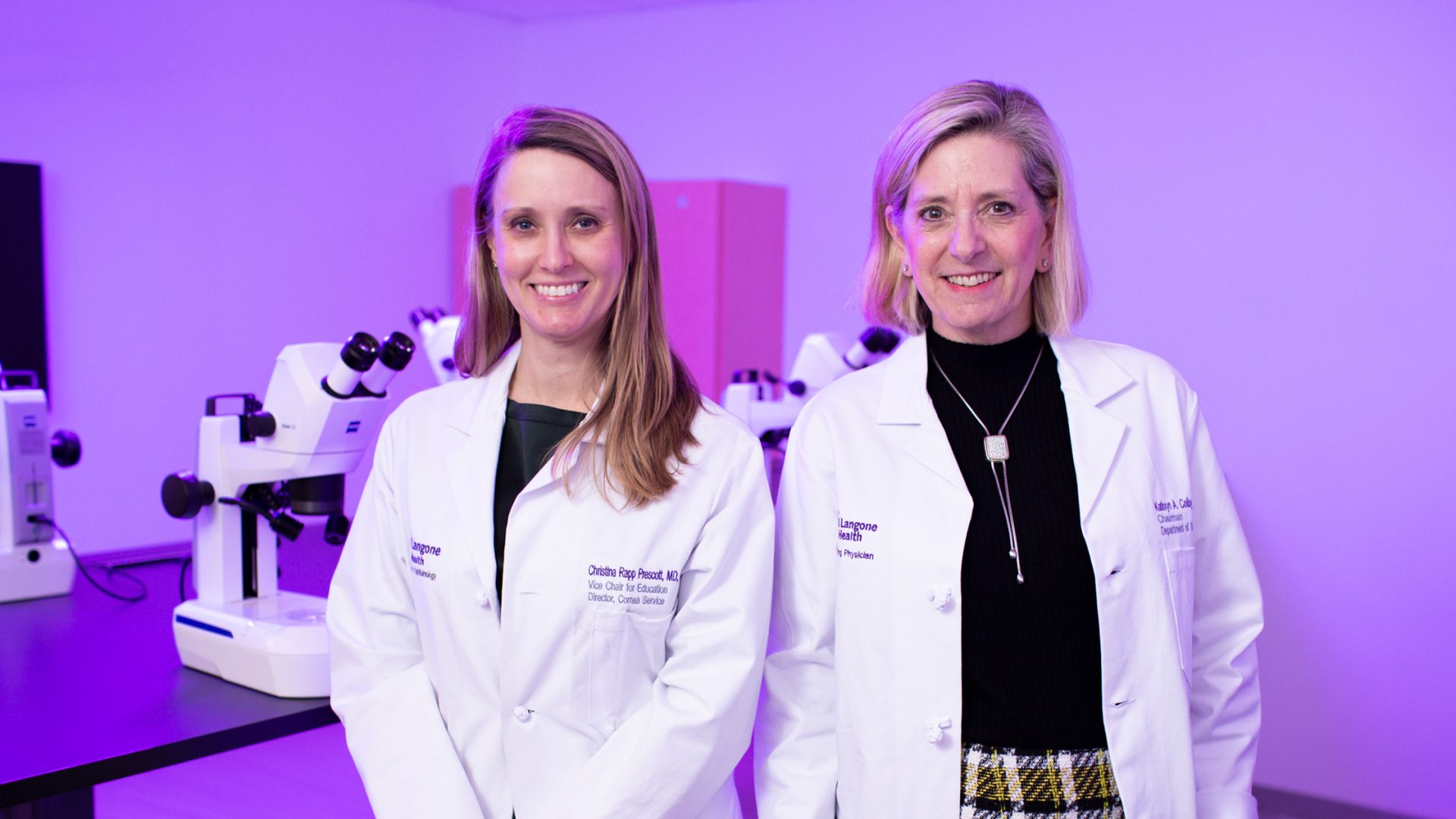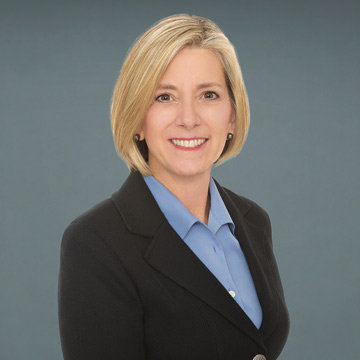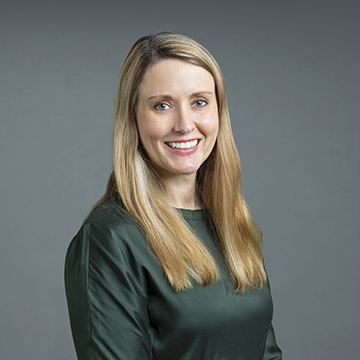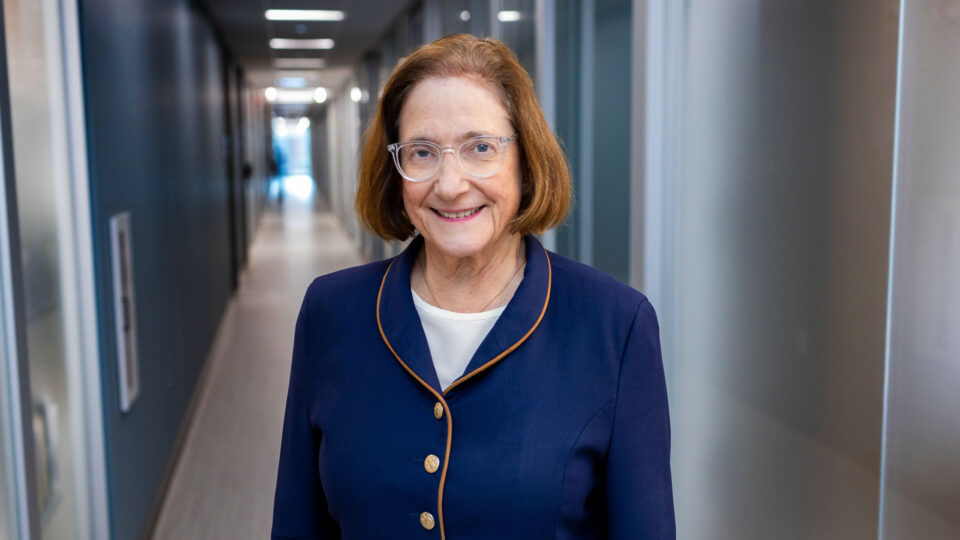While approximately one-quarter of practicing ophthalmologists are female, the numbers lag when it comes to composition of ophthalmic journal editorial and professional society boards and leadership positions in academic ophthalmology departments, says internationally renowned cornea specialist Kathryn A. Colby, MD, PhD, the Elisabeth J. Cohen, M.D., Professor of Ophthalmology and chair of the Department of Ophthalmology. Dr. Colby, who joined NYU Langone Health in 2020, recently authored an editorial in JAMA Ophthalmology on the status of women in ophthalmology.
Christina R. Prescott, MD, PhD, recently joined NYU Langone as director of the Division of Cornea Services and vice chair for education in the Department of Ophthalmology. Here, Drs. Colby and Prescott discuss the state of gender parity, the value of mentorship, and strategies to improve gender equity in the next generation of ophthalmologists.
Inequities in Publishing and Speaking
Physician Focus: Dr. Colby, you’ve written and spoken extensively about gender parity in ophthalmology, especially regarding publications in peer-reviewed journals and invited talks at national conferences. Where does the field land on gender parity?
Dr. Colby: Ophthalmology is still largely a specialty of white men! Recent studies show that ophthalmology departments are among the least diverse of the medical specialties.
Women ophthalmologists do a reasonably good job of publishing, given that the vast majority of ophthalmologists are not in academics. However, when it comes to invited editorials and commentaries, recent articles that show that women lag behind men—that’s what triggered my last editorial.
One study showed the proportion of female ophthalmology editorialists is now approximately 30 percent, up from less than 20 percent in the years between 2005 and 2009, which is encouraging. But most female authors tended to be first authors rather than senior authors. And only one of the 20 journals included had a female editor-in-chief during the time of this study.
The same study showed that only two of 15 society presidents were women in 2018. While there’s been an increase in the overall number of female speakers at nine major ophthalmology meetings, female speakers at national forums tend to give submitted, rather than invited talks. Not surprisingly, having a woman on the program committee appeared to increase the number of women on the stage.
Physician Focus: What are some steps that can be taken to ensure more women are recognized?
Dr. Colby: The composition of editorial boards and program committees is critical. Some journals do a very good job of gender parity in both their editorial boards and invited submissions. When you’re invited to write your opinion, de facto, you’re a thought leader.
Adopting masked reviews is one way—hiding both the name and institution of the author—and some journals have gone to that. Also, as an editorial board member, it is necessary to call it out when you see inequities. As for national forums, women have to continually speak up when the “manels” (all-male panels) are announced.
It’s mostly about raising awareness, not accepting the rationale we’re handed. Although, it is kind of uncomfortable to always be the one to say we need to improve.
Equipping Trainees and Young Faculty
Physician Focus: Dr. Prescott, in your role training the next generation of ophthalmologists, how can we go about equipping women with skills that will help them succeed?
Dr. Prescott: Women now represent more than 50 percent of medical school students and 40 percent of ophthalmology residents. Currently at NYU Langone, more than 50 percent of the residents are female. The question we have to ask ourselves is “Where do women who start out on the academic track and are headed towards the leadership track start dropping off?” Between assistant and associate professor is where we see the biggest drop. Something happens that derails many of our female colleagues.
Dr. Colby: When women decide to start a family, if they don’t see a pathway to make that happen, they may go to part time while they’re raising young children. If you do that early in your career, you never really catch up in the publishing and presenting arena. If you don’t accept an invitation to speak when you are invited, eventually people are going to stop asking you to speak.
Dr. Prescott: Probably the most important thing we can do is to be role models and mentors to young women—to let them know what’s possible by showing them they can take great care of patients, teach, do research, present at meetings and have a family.
In terms of publishing and presenting, we’ve built a formalized research curriculum for all our residents, both male and female. It’s a structured program with a timeline, so residents have time to pursue research and receive help in developing projects so they can determine if this is something they’re interested in. As a group, we discuss journal articles and practice giving presentations. We have visiting speakers come in from the leading academic ophthalmology programs to give our residents additional insights. We ensure that our visiting professorships, including two big name lectures, include women.
Dr. Colby: Networking with other female ophthalmologists is important. The Women in Ophthalmology group has been around for approximately 25 years. In 2019, there were 700 people who attended the meeting. It’s a great place to talk about making the transition to academic leadership positions, balancing work and home, the things we’ve been discussing. It’s been really helpful in raising the consciousness of women in the field.
Recruiting Diverse Applicants
Physician Focus: What about gender breakdowns in academic ophthalmology departments? How do you ensure that you’re recruiting diverse trainees and faculty?
Dr. Colby: It helps to have a woman chair! While there has been an increase in women on academic faculties, the bulk of this increase has been at the assistant professor level. Only about one-quarter of professors are women. Women have lower starting salaries and perform fewer surgeries than men.
This goes beyond gender parity—ophthalmology is also behind in recruiting URiM (underrepresented in medicine) residents. Some medical trainees just aren’t exposed to ophthalmology; not all medical schools have ophthalmology programs. And ophthalmology is highly competitive. Out of 500 residency spots last year, only 80 percent of senior medical students from United States medical schools who applied matched. And the number is much lower for other categories of applicants.
The American Academy of Opthalmology and Association of University Professors of Opthalmology offer minority mentoring programs to help people get into the field. And the Rabb-Venerable Society supports medical students, residents, and fellows in ophthalmology who are from URiM groups. We now hold 20 percent of our residency interview spots for URiM candidates.
Dr. Prescott: We have a program where minority high school students come in and shadow department faculty. The students rotate through different specialties, and get help with the college application process. Programs like this expose students to the possibility of a career in medicine—something they may not have thought about otherwise.
Physician Focus: Any closing thoughts?
Dr. Colby: While there is definitely more awareness, there is still unconscious bias. We all need to pay attention to parity when we invite speakers, give awards, generate research collaborations, write job offers, and appoint committee members. Those of us in leadership positions need to model diversity. Implementing these things is how we’re going to see the downstream effects.
Dr. Prescott: Working with medical students, residents and fellows, I am continually reminded that each we all have different strengths and weaknesses. The more diverse our specialty is, the more we can all learn from each other, and the better we can care for our patients.







